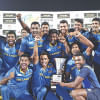Tough task for Tigers
Three stats dominate the discussion before Bangladesh and Sri Lanka lock horns in the first of two T20Is at the R Premadasa International Stadium in Colombo tonight at 7:30pm (Bangladesh time).
Sri Lanka have won four of their last five T20Is, including two series in the T20I strongholds of South Africa and Australia. Bangladesh, on the other hand, have lost seven straight T20Is going back to the World Twenty20 around a year ago. The wildcard stat thrown into the mix is that Sri Lanka have lost 10 out of 11 ODIs at the Premadasa.
Therefore, on a tour where the visitors have often had to fight against the tide of history as far as ground records go, today's T20I starts with the hosts having some course correction to do as well. While there is something to be said for the notion that history does not really matter in the game's shortest format and consequently the one which is most influenced by stray bits of fortune, it is still worth it to unpack those three stats.
Sri Lanka's 10 losses at the Premadasa go back to February 2009, and there really is no shame in losing to the teams -- India, Pakistan, New Zealand, West Indies, South Africa and Australia -- that bested them at today's venue over the last eight years. Leaving aside the Premadasa, they have a 14-11 win-loss record in the format at home, and a 4-1 advantage over Bangladesh in T20Is. On the other hand, the 2-1 series wins in South Africa and Australia may be a source of great confidence for the home side, but the South African side was one without the likes of Hashim Amla, Faf du Plessis, Dale Steyn, Morne Morkel or Kagiso Rabada while AB de Villiers played just one game. The Australian side, meanwhile, was without most of their main players who started the first Test match in India barely 15 hours after the third T20I down under.
"When we played the decider against England in Chittagong, we lost despite having a good record there," said Bangladesh captain Mashrafe Bin Mortaza when asked about Sri Lanka's poor Premadasa record. "So these things don't really matter much."
The one stat that is most relevant is Bangladesh's past record. In subcontinental conditions in India in the World Twenty20, they lost four group matches on the trot against Pakistan, Australia, India and New Zealand before going to New Zealand and losing all three T20Is earlier this year. Also among those eight defeats is arguably their most painful defeat in recent times -- the World T20 group match against India which they lost after needing two to win off three balls.
They have also won just five matches against Test teams other than Zimbabwe, and only 20 out of 65 overall in the format. The only positive for Bangladesh seems to be that in the teams' last meeting in February 2016 in the Asia Cup in Dhaka, Bangladesh came out trumps. But recent form and the personnel at hand makes it a tough ask for the tourists to reverse this particular trend.
Sri Lanka have the legendary Lasith Malinga set to continue his appearances in the shortest format after making a comeback during the Australia T20Is during which he looked a little sluggish but effective nonetheless. But now seems fitter and closer to his best as he was firing in the yorkers at pace at the centre wicket under lights during practice yesterday.
Nuwan Kulasekara is expected to share the new ball, and if his four wickets in the last ODI are any indication, the movement he generated under lights will arguably be even more lethal, and unlike in ODIs, there will be little time for Bangladesh to recover. Then there is Lakshan Sandakan, the chinaman bowler who had troubled Bangladesh in the Tests. Sri Lanka's batting may be a weak point, with no Angelo Mathews, but there is still enough firepower in the likes of Kusal Perera, Upul Tharanga and Bangladesh's scourge in the late order, Thisara Perera.
While Sri Lanka have opted for an experienced squad with their youngest player being Vikum Sanjaya at 25, Bangladesh have chosen to include some youngsters in the squad, drafting in the 20-year-old seam-bowling all-rounder Mohammad Saifuddin. It is perhaps the bowling that will be more important for Bangladesh, and they will be looking to Mustafizur Rahman to regain some form after an indifferent ODI series. The uncapped Mehedi Hasan Miraz's possible inclusion may be of interest too; it is as yet uncertain what Bangladesh's bowling line-up will be. It may be a repeat of the ODI attack that performed generally well.
On the batting front much will depend on Tamim Iqbal, and he may be required to play a role similar to that he performed in the first ODI in Dambulla by batting through the overs so that the others can bat around him.
However, it seems that if both teams play at their best, Sri Lanka will have more firepower to reverse their Premadasa record.










Comments